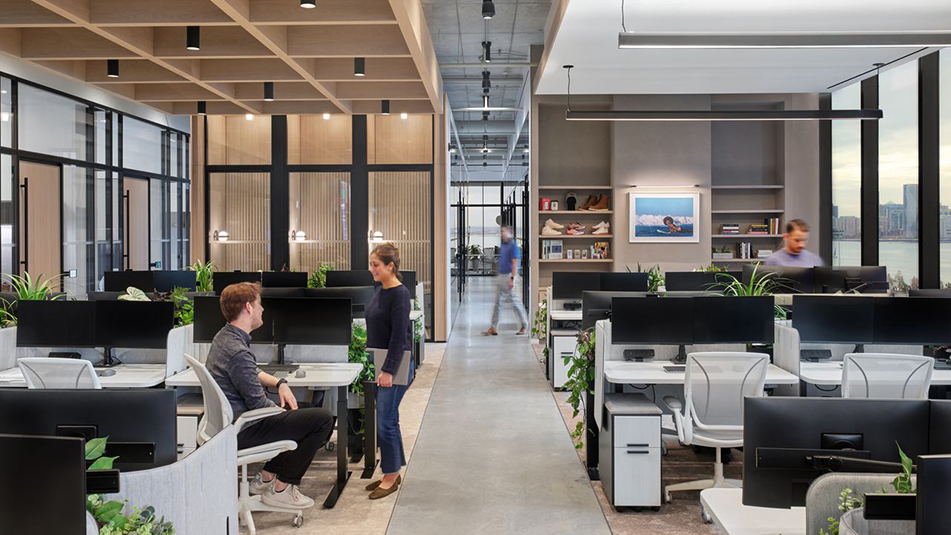It goes without saying that the coronavirus pandemic has brought a variety of unexpected changes to the workplace in 2020. While many of these changes to the work environment have proven to be challenging, like learning how to be comfortable working remotely, there have been several positive effects. Not only have we had to reevaluate how we work, but the pandemic brought to light the importance of flexibility in the workplace. As companies determine how to function to the best of their ability during this difficult period and in the future, offices are finding ways of becoming more adaptable, which could certainly benefit many workplaces and their most valuable asset - people.
There are a variety of terms for the new work environments popping up, like agile, hybrid, activity-based, and shared/co-working – but what does this all mean?
Co-working
You may already be familiar with this term, thanks to popular venues like WeWork and WorkBar, that allow different companies to share office space and minimize costs. Advocates praise its ability to put people in diverse industries side-by-side, utilizing the power of community to exchange ideas. Before the pandemic hit, co-working spaces were popular throughout Boston, using a significant amount of the city’s commercial real estate. However, co-working spaces have lost some of their luster during the pandemic as people seek to prevent the spread of COVID. Despite this, many still find the co-working movement to be powerful. According to an October survey of global providers from Workthere, 42 percent of flex space/co-working providers said they were optimistic about the sector’s future. Clearly, the movement still has many believers, including the legions of employees who say it fosters collaboration by creating an unorthodox office space.
Agile
In an agile work environment, the meaning is all in the name. It embraces a flexibility that allows employees the freedom to work in different areas of the office whenever they choose. This means designating certain areas for collaboration and chat, while others are deemed “quiet” spaces for solitary work. This style has proven to be effective in a pre-COVID environment, as talent management firm BSP World found that 67% of agile businesses reported a significant boost to their productivity, up to 20% in some cases. There are several additional benefits, including reduced real estate and facility management costs, as well as a strong sense of collaboration for a more successful outcome. In a post-COVID world, an agile work environment will still be beneficial. Not only will it continue to encourage the flexibility and freedom that employees want, but it will help attract new talent and allow current employees to flourish.
Activity-Based Working (ABW)
ABW is a similar concept to an agile work environment, allowing employees to pick from several settings based on what type of task they are doing, whether it’s inside or outside of the office. However, these two concepts do have some differences. In contrast to an agile work environment, ABW is focused more on the individual, rather than a teamwork-focused methodology.
Hybrid Workplace
Recognizing that a “one-size-fits-all” work environment isn’t ideal for everyone; this strategy emphasizes allowing team members to work remotely when and where they want. In a hybrid work environment, employees have the ability to brainstorm and use each other as vital tools for collaboration, while also possessing the autonomy to choose their office hours and create a greater sense of balance. Companies like Microsoft have found this system to be particularly efficient during the pandemic when gathering in the office isn't possible. A hybrid workplace is a flexible one that emphasizes the autonomy of the employee to choose how they individually are most productive, blending office and remote work. The ability to leverage technology, like video conferencing, in conjunction with traditional collaboration methods is also a touchstone of a hybrid workplace.
Disrupting Conformity
While many companies were used to a traditional work environment that emphasized 40-plus hours per week in a cubicle, the pandemic has demonstrated that a “one-size-fits-all” mentality no longer works. According to research conducted by Future Forum, a survey of 4,700 office workers currently working remotely found that the majority never want to go back to the old way of working. Just 12% said they want to return to full-time office work, while 72% said they preferred a hybrid remote-office model. Looking toward the future, companies will need to recognize that the way their employees want to work will look different. It will be necessary to customize the work experience for each organization and give more flexibility to employees to choose what works best for them.
Fostering Change
As companies navigate the changing face of the office, it’s important they recognize the many ways they can support employees in these new work environments. Organizations should continue to foster collaboration in new, tech-driven ways. McKinsey predicts that futuristic ideas like always-on video conferencing, in-person and remote collaboration spaces like virtual whiteboards, and asynchronous collaboration will become par for the course. Team members will be incentivized to work harder if they're provided with the necessary tools and flexibility with where and how they work they so much desire.
Cresa’s team of experts can provide valuable insight to help you examine what type of work environment is best for your organization. Working together, we can establish a real estate and workplace strategy that best supports your business objectives and goals.



